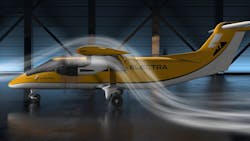Electra completes wind tunnel testing for ultra-short takeoff aircraft
CAMBRIDGE, Mass. - Aerospace firm Electra.aero, Inc. in Manassas, Va., announced it has completed powered wind tunnel testing of its nine-passenger hybrid-electric EL9 aircraft, confirming the viability of its "blown wing" design that enables ultra-short takeoffs and landings.
The testing, conducted using a 20 percent scale model of the EL9 wing, demonstrated lift coefficients exceeding 20 - roughly seven times that of typical unblown wings. According to the company, the results validate the aircraft’s ability to take off and land within just 150 feet, or about 10 percent of the runway length required by conventional aircraft in its class.
"This is a major milestone in demonstrating the EL9’s ability to take off and land in spaces never before possible for fixed-wing aircraft," said Chris Courtin, Electra’s director of technology development. "Verification of the effectiveness of the optimized EL9 wing shows that the EL9 is both transformative and practical."
U.S. Navy to explore use of Electra.aero's commercial-focused eSTOL for logistics
Electra said the EL9 meets FAA Part 23 safety and stall margin requirements, supporting stable and predictable flight performance at low speeds. The aircraft is being designed for both commercial and military applications, including access to remote areas, operations in noise-sensitive environments, and use on unimproved surfaces.
Dual use
The U.S. Army supported the wind tunnel testing under a Small Business Innovation Research (SBIR) contract, as it evaluates the technology’s dual-use potential.
Electra is continuing to refine the aircraft’s design alongside flight tests of its EL2 demonstrator. The company reports more than 2,200 pre-orders from over 50 global operators, with a projected value of $10 billion. Initial test flights of the EL9 are planned for 2027, with certification and commercial entry targeted for 2029.
In 2024, Electra announced that the U.S. Navy had awarded Electra a contract under the Naval Air Systems Command (NAVAIR) to explore the use of Electra's electric short takeoff and landing (eSTOL) aircraft as a next-generation aviation solution for logistics in a contested environment.
In this study, Electra will work with Navy stakeholders to define specific contested logistics use cases and conduct a conceptual design study to evaluate how its hybrid-electric eSTOL aircraft can address unique Navy capability gaps. Contested logistics, a key topic of national security interest, essentially refers to the movement of military personnel or supplies to and from areas that are challenging to reach or support.
About the Author
Jamie Whitney
Senior Editor
Jamie Whitney joined the staff of Military & Aerospace Electronics in 2018 and oversees editorial content and produces news and features for Military & Aerospace Electronics, attends industry events, produces Webcasts, and oversees print production of Military & Aerospace Electronics.
